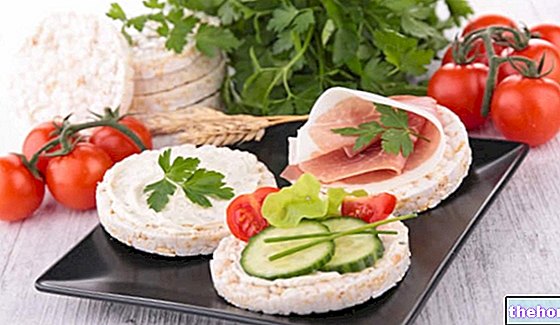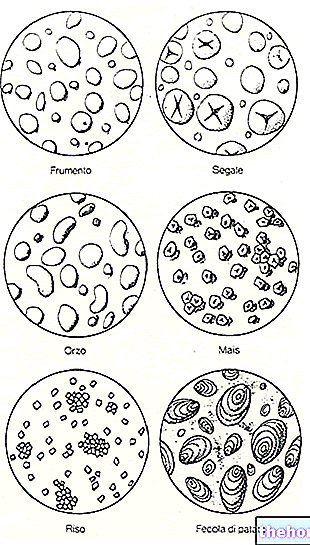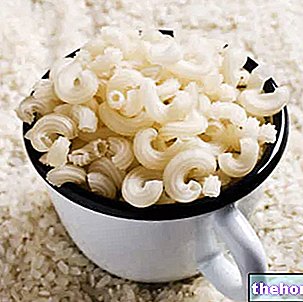From this first statement it can be deduced that rice cakes are not exactly the prototype of a dietetic food; moreover, they are much more energetic than traditional bread. The latter provides on average just under 300kcal / 100g, so a single slice of bread (25-30g) provides about 75-90kcal. "energy but has a total weight 2.5 / 3 times higher. In practice, a slice of bread has double the calories but boasts three times the satiating power.

The calories of rice cakes are mainly provided by carbohydrates, followed by lipids and finally by proteins. The carbohydrates are almost totally complex (starch), the fatty acids are unsaturated and the peptides have a medium biological value.
Rice cakes provide an insufficient water fraction, do not contain cholesterol and their portion of dietary fiber is quite high.
From a saline point of view, rice cakes provide a good level of phosphorus, potassium and iron (even if the latter is not very bioavailable). As for vitamins, however, the concentrations of niacin (PP), folate stand out. total (not present in the table and probably canceled by the heat treatment of puffed rice) and tocopherols (vit E).
Rice cakes do not contain simple sugars but, having a high glycemic index (82 out of a maximum value of 100 of the glucose syrup), they are NOT suitable for the diet of the obese, type 2 diabetic and hypertriglyceridemic.
Among other things, due to the lack of water, the content of dietary fiber could (rather than improve) worsen a "possible condition of constipation; in the event", it is therefore essential that the rice cakes are accompanied by plenty of water or drinks.
It is also important to point out that not all rice cakes are suitable for vegetarian and vegan diets, as some use food additives of animal origin such as, for example, isinglass as a glue.
A "final clarification concerns the" suitability of rice cakes for celiac nutrition. Many think that, being based on rice, the cakes can be easily inserted. However, some of them are produced with glutinous rice, which is why it is always necessary to carefully read the label of the individual products at the time of purchase.
The average portion of rice cakes varies according to the composition of the general diet; in a 2000kcal nutritional regime, if used as a secondary snack, it is possible to use 20-30g of rice cakes (i.e. 80-115kcal).
Since these are two compounds considered poisonous - since, at a "high and long-lasting exposure, they can increase the risk of cancer - the researchers considered it appropriate to inform the community on the respective levels in food and on the safety margins; it would in fact be lawful for the consumers want to adopt containment measures for acrylamide and arsenic, in order to moderate the risks associated with their presence in the diet.
Researchers argue that consumers have no reason to worry about most unwanted chemical compounds in foods, including arsenic and acrylamide, especially in the context of a varied and heterogeneous diet.
However, the "National Food Institute" claims that "it would be beneficial for everyone if the intake of certain compounds were reduced"; these compounds obviously also include inorganic arsenic and acrylamide.
; Furthermore, for children, it seems that the biscuits represent the main way of entry of the aforementioned contaminants.
In light of these certainties, the average intake of inorganic arsenic with food (albeit within the safety margins) should be reduced, especially for children. This is because smaller, developing organisms have a lower tolerance than adult ones; remember that, if consumed in large quantities and for many years, the chemical element in question could increase the risk of developing some forms of cancer.
It would therefore be desirable (in the diet of those who eat this cereal above all, such as Asian populations or some Western celiacs) partially replace rice with potatoes, bread (possibly gluten-free), legumes or other vegetables, to vary the diet and reduce exposure. to poison.
While research suggests that, since 2007, the "average intakes of acrylamide for the population have declined," there are those who argue that the levels are still too high.
According to a report of the year 2013, 36% of the acrylamide in the adult diet comes from packaged foods such as potato chips, 30% from coffee and 13% from bread and derivatives (including, of course, also biscuits. of rice).
often contain a mixture of micronized zeolite (detoxifying volcanic mineral based on silicon and aluminum), alpha lipoic acid (a powerful antioxidant) and / or other antioxidant molecules of vitamin, mineral, polyphenolic, coenzyme origin, etc.
The composition is justified by the fact that alpha lipoic acid, as well as the other components mentioned, could help limit the oxidative stress caused by acrylamide, thanks to its remarkable ability to neutralize harmful free radicals throughout the body. Meanwhile, the zeolite, thanks to a "cage" chemical structure, should exchange heavy metals (including the aforementioned arsenic) in the environment, releasing its ions and preventing toxins from remaining inside the organism.
To tell the truth - if it is shown that zeolite can effectively exchange its ions with heavy metals, caging them, and that antioxidants have some effectiveness in fighting oxidative stress - there is no guarantee that the aforementioned supplements can cancel the presence or the effect of arsenic and acrylamide in food. Among other things, the use of clays in food supplements has recently been banned by the Ministry of Health, in order to reduce consumer exposure to food sources of aluminum.
Taking antioxidant and "detoxifying" supplements may therefore be a "correct habit, but diet remains the most important form of prevention of all."
Other Cereals and Derivatives Amaranth Wheat starch Corn starch Rice starch Modified starch Oat starch Bulgur Whole grains Corn Flakes Crackers Oat bran Bran Cus cus Amaranth flour Oat flour Buratto flour Spelled flour Buckwheat flour Corn flour Corn flour Millet Barley flour Quinoa flour Small spelled flour (Enkir) Rice flour Rye flour Sorghum flour Flour and semolina Whole wheat flour Manitoba flour Pizza flour Spelled Rusks Focaccia Nuts Wheat or wheat Wheat germ Burnt wheat Buckwheat Breadsticks Oat milk Rice milk Corn Maizena Malt Millet Muesli Barley Stale bread Unleavened bread and Pita Bread Carasau bread Egg pasta Rice pasta Wholemeal pasta Piadina Small spelled Pizza Pop corn Baked goods Quinoa Rice Basmati rice Converted rice White rice Rice Wholemeal Parboiled Rice Puffed Rice Venus Rice Rye and Horned Rye Semolina Semolina Sorghum Spaghetti Spelled Teff Tigelle Triticale OTHER ARTICLES CEREALS AND DERIVATIVES Categories Food Alcoholics Meat Cereals and derivatives Sweeteners Sweets Offal Fruit Dried fruit Milk and derivatives Legumes Oils and fats Fish and fishery products Salami Spices Vegetables Health recipes Appetizers Bread, Pizza and Brioche First courses Second courses Vegetables and Salads Sweets and Desserts Ice creams and sorbets Syrups, liqueurs and grappas Basic Preparations ---- In the Kitchen with Leftovers Carnival Recipes Christmas Recipes Dietary Recipes Light Recipes Woman's Day, Mother's Day, Dad's Day Functional Recipes International Recipes Easter Recipes Recipes for Celiacs Recipes for Diabetics Holiday Recipes Valentine's Day Recipes Vegetarian Recipes Protein Recipes Regional Recipes Vegan Recipes
















.jpg)











